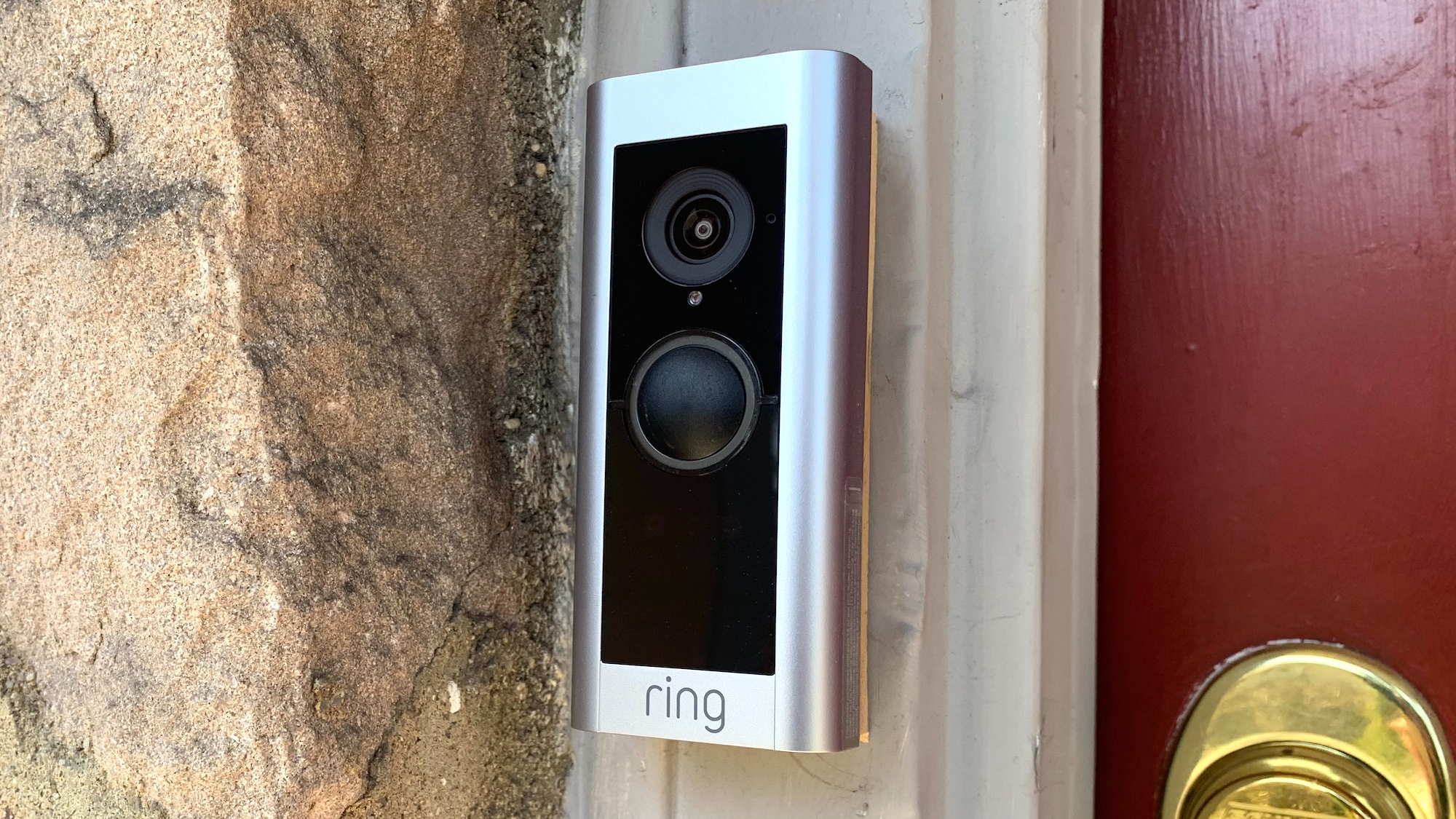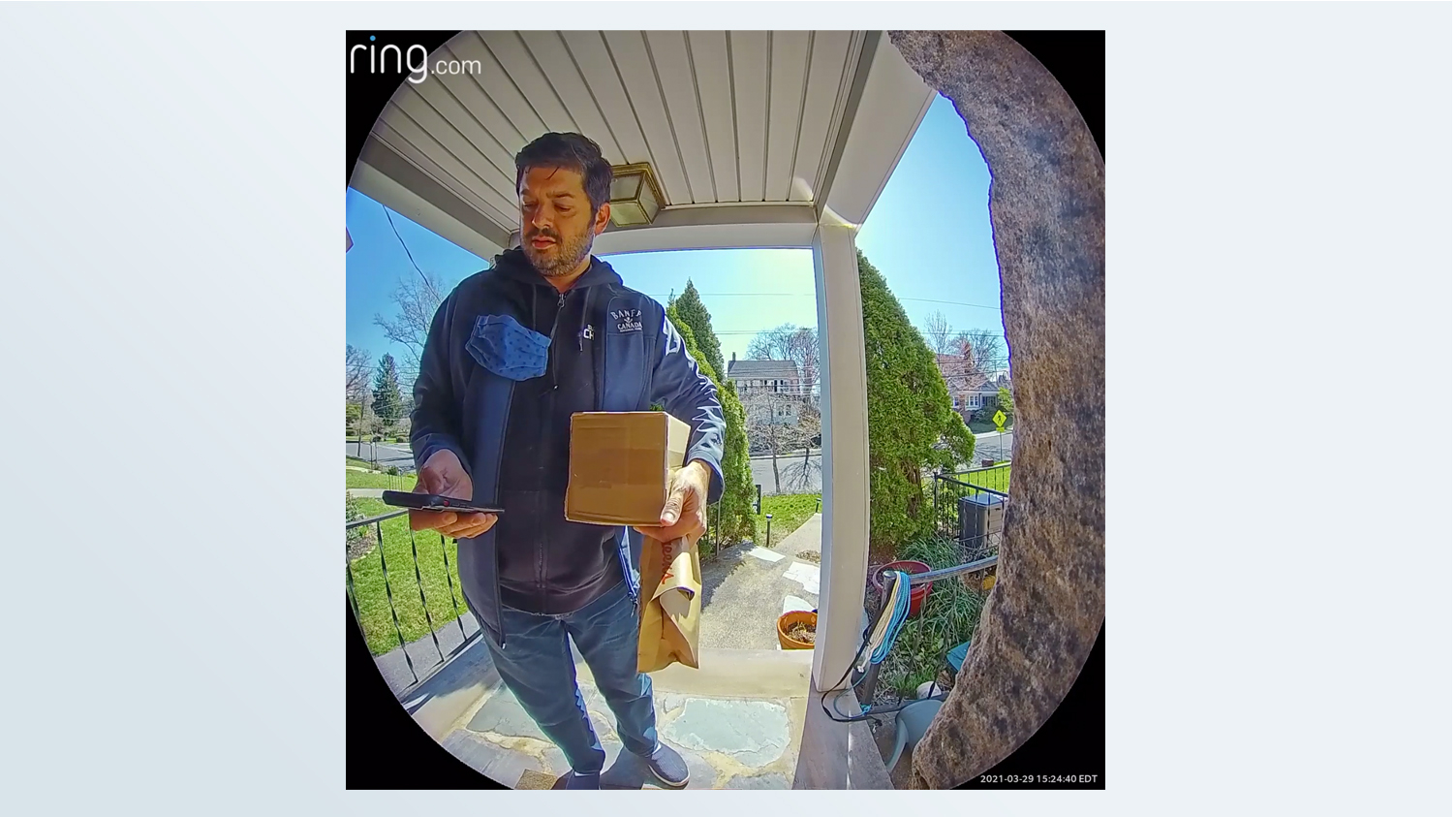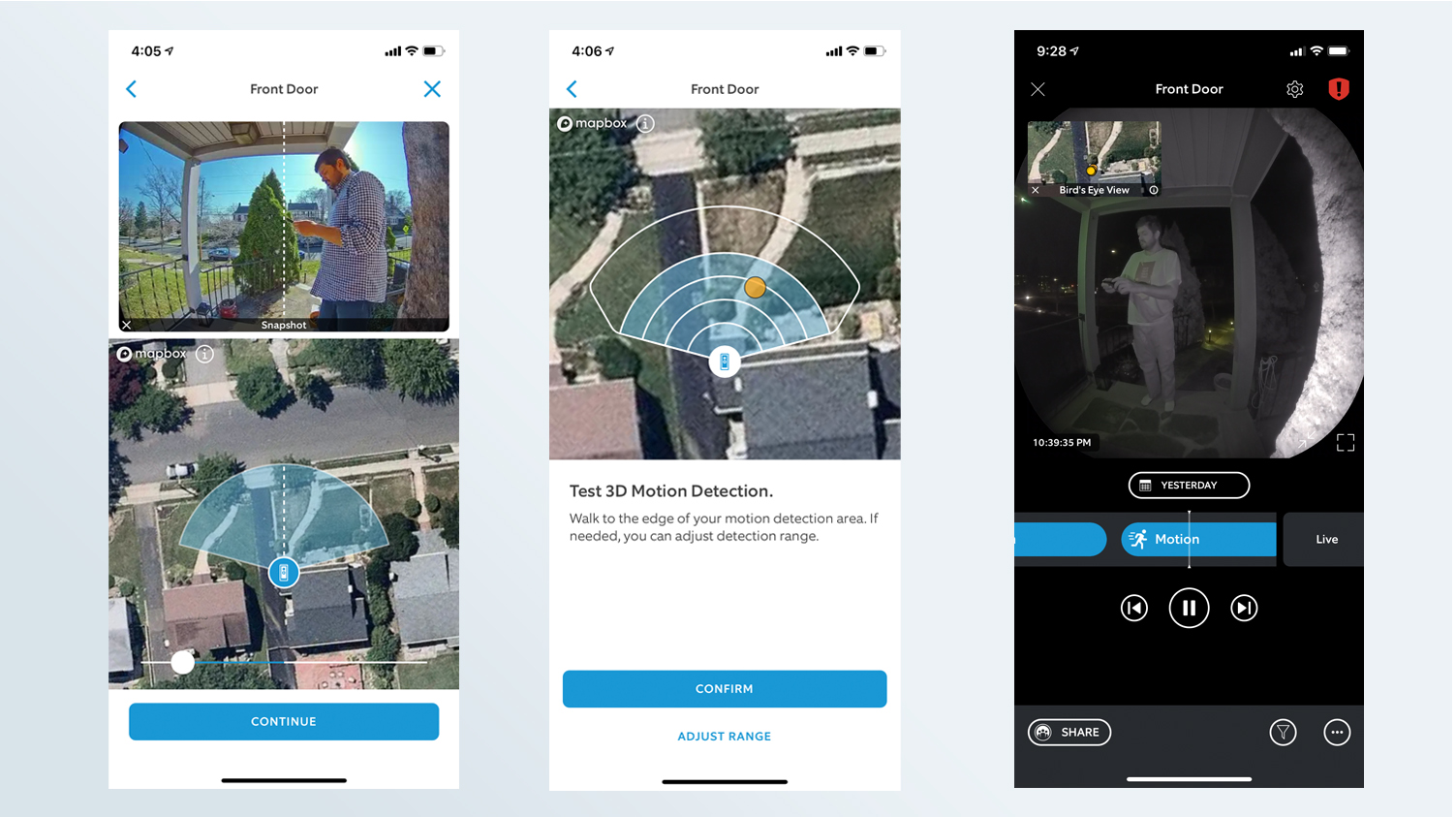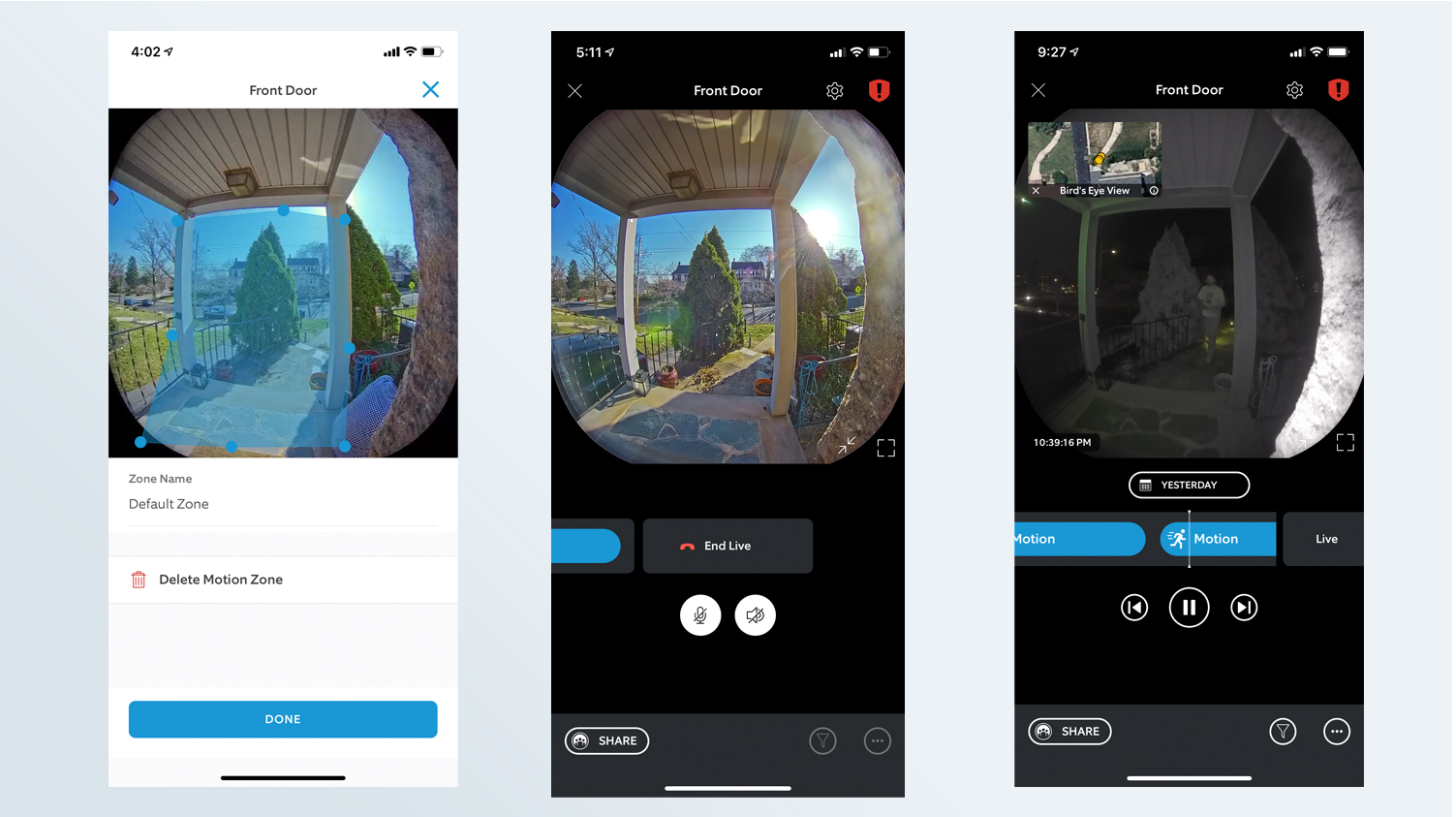
Size: 4 x 1.8 x 0.88 inches
Resolution: 1536 x 1536
Field of View: 150 x 150 degrees
Battery: No
Wi-Fi: 802.11 b/g/n (2.4GHz and 5.0GHz)
The Ring Wired Video Doorbell Pro is proof that It’s time that video doorbells showed the world in a different way. That’s because the majority of these devices — which we trust to let us know who and what is at our front door — haven’t been showing us all of our front stoops. That means you can’t see all those packages dropped off by FedEx and UPS just by looking at a live feed from your video doorbell.
The Ring Wired Video Doorbell Pro is the first video doorbell from Ring whose camera has a square aspect ratio. That is, you can see as much up and down as you can left to right, and with a 160-degree field of view, that means you can also see a lot more of the area in front of your door than before. This feature alone is enough to recommend it as one of the best video doorbells, but there are some other new tricks you’ll find in this Ring Wired Video Doorbell Pro review.
Ring Wired Video Doorbell Pro review: Price and availability
The Ring Wired Video Doorbell Pro was released on March 31 2021, and costs $249. The original Ring Video Doorbell Pro has been discounted to around $140, and will likely remain around that price until inventory runs out.
While the Ring Wired Video Doorbell Pro comes with a silver faceplate (it’s called Satin Nickel), Ring is offering 16 color options, which cost $15 each.
Aside from the Ring Video Doorbell Elite, which requires professional installation, the Ring Wired Video Doorbell Pro sits at the top of Ring’s lineup, and it’s the most expensive model. Below that are nearly half a dozen video doorbells, from the $59 Ring Video Doorbell Wired to the $169 Ring Video Doorbell 3 Plus. Here’s a comparison of the Ring Video Doorbell vs. the Ring 3 vs. the Ring Pro.
Ring Wired Video Doorbell Pro review: Design
Now that it’s nearly a dozen video doorbells in, Ring has a pretty established design ID, and the Ring Wired Video Doorbell Pro sticks to it. Like just about every other video doorbell — Ring or otherwise — the Pro 2 is rectangular, with a camera at the top and a lighted button below.

Because the Ring Wired Video Doorbell Pro does not have a battery of its own, it’s a lot slimmer than the Ring Video Doorbell 3 and others of its ilk. But, this also means that the Pro 2 needs to be installed where there’s existing doorbell wires.

Ring Wired Video Doorbell Pro review: Video quality
Probably the best thing about the Ring Wired Video Doorbell Pro is not its resolution or how well it sees, but what it sees. That’s because the Pro 2’s camera has a square aspect ratio and a 150-degree field of view both vertically and horizontally. The vertical FOV is the one that’s most critical; from a practical point of view, it means that you can see much closer to the foot of your door — which means it’s more likely that you’ll see when packages are dropped off.

You don’t get a full head-to-toe view—the Pro 2 cut off about 18 inches from the front of my door — but it’s a lot better than most other video doorbells, which omit as much as the first three feet of my stoop.
Daytime video from the Pro 2 was excellent. My covered front porch faces south, so I get a lot of severe shadows in the afternoon. But thanks to the HDR setting, I could see everything in the shadows easily despite the Sun shining directly at the camera. There was a bit of lens flare, but nothing worse than you’d see in a JJ Abrams movie. Nighttime video wasn’t as clear, but a visitor was still identifiable.
Despite the camera having such a wide field of view, there was very little fisheye effect — the curving of the image which is common in lenses like this — so visitors’ faces weren’t distorted.
Ring Wired Video Doorbell Pro review: Motion Detection and other features
Apart from the wider field of view, Ring added two new features to the Pro 2: 3D Motion Detection and Bird’s Eye View, which purport to help reduce unwanted notifications and better track people who might be around your property.
3D Motion detection uses radar rather than the camera to detect a person’s movement up to 30 feet away. Bird’s Eye View overlays an overhead map of your property, and when the camera detects a person, it displays a track of where that individual was walking.
In practice, I didn’t find either of these features all that useful. For starters, there are two large trees on either side of my front porch, which obscures large sections of my front lawn; if the Ring can’t see you, then it can’t track you. The Bird’s Eye View was nice to have, but it didn’t really tell me anything I couldn’t already see from the video.
As with the original Video Doorbell Pro — and pretty much every other video doorbell — the Pro 2 has customizable motion zones, as well as a motion-sensitivity setting. Both were easy to set up, but I found that even with the motion zone excluding my street and sensitivity dialed down to 33 percent, I still received the occasional notification when a car drove by. On a particularly windy day, I turned on person-only notifications to keep the doorbell from alerting me every time a bush blew in front of my door.
Another useful feature is Pre-roll video. The Pro 2 constantly records a 4-second loop, and when there’s a motion event — say, someone coming to your door — it tacks those four seconds to the front of that event. It’s supremely helpful, as you get a much better view of the person.
The Pro 2 also lets you filter notifications so that you only get alerts if the camera detects a person, but there are no settings for vehicle or animal detection, as there are with the Nest Hello and Arlo video doorbells. However, as of September 2021, the Pro 2 now has package detection.

Ring Wired Video Doorbell Pro review: Privacy and Security
After a number of concerns regarding its privacy and security features, Ring rolled out several changes to its cameras and app. For starters, you are now required to use two-factor authentication, to help prevent others from breaking in and taking over your account.
Footage uploaded to Ring’s servers is encrypted, as is footage as its transferred from a Ring device to the cloud or your smartphone. Ring is currently testing end-to-end encryption, and will roll out to all users later this year.
As with other Ring cameras, the Ring Video Doorbell 2 works with the Neighbors app, allows you to see other incidents in your area (categories include safety, crime, lost pets, and neighborly moments) and, if you have a Ring camera, upload footage from your camera for all on the app to see.
The more contentious feature is Ring’s partnership with law enforcement agencies around the country. If a local police department is enrolled with Ring’s program (there are now more than 1,000 throughout the U.S.), they can request video footage from Ring cameras of a particular incident. Ring will then send a request to Ring owners in the area of that incident; it’s up to each person whether or not they want to share the video. In the Ring app, you can opt out of receiving these notifications, and the company says that it does not share your information or videos unless you choose to do so.
In July 2021, Ring launched end-to-end encryption for its video doorbells and home security cameras, which includes the Ring Wired Video Doorbell Pro. Here is a complete list of Ring video doorbells with end-to-end encryption as well as instructions on how to enable the feature.
Ring Wired Video Doorbell Pro review: Smart responses
Remember that scene in Ferris Bueller’s Day off where he rigs his home’s intercom to play pre-recorded messages to Ed Rooney? Well, you can now do that with Ring’s video doorbells via Smart Responses, only it’ll be Alexa’s voice, not yours.
Alexa Greetings uses Amazon’s voice assistant to either take a message or tell a delivery person where to leave a package.
Quick Replies lets you choose from six prerecorded messages that will play if you don’t answer the doorbell within a certain amount of time (anywhere from immediately to 20 seconds - you can pick the interval).
Alexa Greetings are only available on the Ring Video Doorbell Pro and Pro 2, but Quick Replies can be used with any Ring video doorbell. Both of these features require a Ring Protect subscription, which starts at $3/month or $30/year.
Ring Wired Video Doorbell Pro review: Installation
Like its predecessor, the Ring Wired Video Doorbell Pro has dual-band Wi-Fi (802.11b/g/n). This helps it connect to more modern Wi-Fi networks, though you’ll still want the Chime Pro ($49.99) if your front door is far from your router. While I have a fairly strong mesh network throughout my house, I still received a “poor signal” alert from time to time with the Pro 2. The Chime Pro acts as a bridge between the video doorbell and your Wi-Fi network, ensuring a better connection.
The Pro 2 will work with standard mechanical doorbell chimes, but you do have to connect a small battery to your chime. It added maybe five minutes to the total installation time, which took in all about 20 minutes.
Ring Wired Video Doorbell Pro review: Smart Home compatibility
Ring’s products go well beyond video doorbells. The company now has smart lights, home security cameras, smart plugs, and even one of the best DIY smart home security systems, and they all work in concert with each other. For example, I have a set of Ring Solar Pathlights leading to my front door; if they detect motion, they’ll not only turn on, but also tell my Ring video doorbell to start recording.
Ring’s video doorbell also works with Alexa and Amazon’s smart displays. So, I could say to the Amazon Echo Show “show me my Ring Video Doorbell,” and a live feed from its camera would appear on the Show. You can also receive notifications on smart displays as well as Fire TV devices, so that when someone rings the bell, video will automatically appear on your screen.
However, while you can control Ring cameras to a limited extent with Google Assistant, you can’t use it to view your cameras on the Nest Hub
Ring Wired Video Doorbell Pro review: Verdict
It’s hip to be square. Without a doubt, the best new feature in the Ring Wired Video Doorbell Pro is the wider vertical field of view which shows much more of your front stoop and whatever happens to be lying there. It’s not perfect — you still can’t see all the way to the bottom of your door — but it’s a big improvement over previous doorbell cameras.
When it comes to wired-only video doorbells, we slightly prefer the Nest Doorbell (Wired), as it can identify familiar faces from your Google Photos, and has package detection for free (rather than requiring a subscription, as Ring does) and it also works with both Alexa and Google Assistant smart speakers. But, the Ring Wired Video Doorbell Pro shows a better way of looking out at your front door than before.







